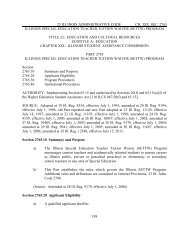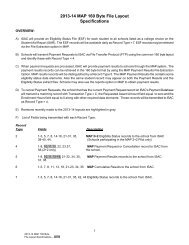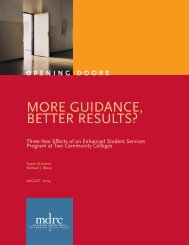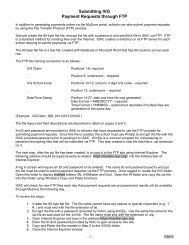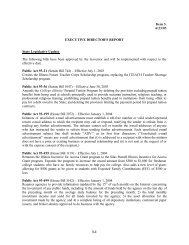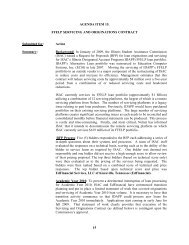High school rigor and good advice: Setting up students to succeed
High school rigor and good advice: Setting up students to succeed
High school rigor and good advice: Setting up students to succeed
Create successful ePaper yourself
Turn your PDF publications into a flip-book with our unique Google optimized e-Paper software.
The ELS 2002 data<br />
Technical notes on methodology<br />
This report examines postsecondary education persistence using the Educational Longitudinal Study<br />
(ELS) from 2002. The study collected data from a nationally representative sample of 2002 high <strong>school</strong><br />
sophomores, <strong>and</strong> collected follow-<strong>up</strong> data from them in 2004 as seniors, <strong>and</strong> again in 2006. From the<br />
original sample of over 16,000 <strong>students</strong> this report looked at the 9,060 <strong>students</strong> who:<br />
1. Graduated high <strong>school</strong><br />
2. Enrolled in a two or four-year institution immediately following their senior year<br />
3. Were still enrolled in January of 2006<br />
Issues in Measuring Persistence<br />
These 9,060 <strong>students</strong> represent over two million <strong>students</strong> in the United States. For the definition of<br />
persistence in this report, a student who started <strong>school</strong> in a four-year college the summer or fall<br />
immediately out of high <strong>school</strong> (2004) was counted as persisting if in January of 2006 they were either<br />
still enrolled in that college, transferred <strong>to</strong> another four-year college, or transferred <strong>to</strong> a two-year<br />
institution. Conversely, if a student started at a two-year institution <strong>and</strong> transferred <strong>to</strong> a four-year college<br />
then this was also counted as persisting. This definition of persistence reflects the national goal of<br />
increasing the number of <strong>students</strong> with some sort of post-secondary degree. One assumption of this<br />
report is that a student who transfers from a four-year <strong>to</strong> a two-year institution should count as persisting<br />
<strong>to</strong>wards obtaining a degree, <strong>and</strong> vice versa.<br />
There are many critiques of using the particular definition of persistence in this report. First of all, not all<br />
<strong>students</strong> start college in the summer or fall term directly after high <strong>school</strong>. There is a modest bias in<br />
drawing samples from <strong>students</strong> who enroll immediately after high <strong>school</strong>. Earlier longitudinal studies<br />
show that of college-going 12 th graders who start college within a year after high <strong>school</strong>, 6 percent in the<br />
summer, 82 percent start in the fall, <strong>and</strong> 12 percent in the winter/spring (Adelman 2006). The definition of<br />
persistence used in this report might therefore overestimate the true persistence of <strong>students</strong> from their<br />
first <strong>to</strong> second year because Latino <strong>students</strong>, African American <strong>students</strong>, <strong>and</strong> <strong>students</strong> with a low socioeconomic<br />
status are less likely <strong>to</strong> start in the fall. These student populations have higher rates of nonpersistence.<br />
However, this slight bias is unlikely <strong>to</strong> drastically effect persistence calculations in this<br />
report, <strong>and</strong> the sample has an appropriate number of <strong>students</strong> from every SES level <strong>and</strong> from the<br />
traditionally underrepresented races. This report looks at <strong>students</strong> that start immediately after high <strong>school</strong><br />
because we can more easily find correlations between high <strong>school</strong> variables <strong>and</strong> their effects on<br />
persistence. While imperfect, this definition is adequate <strong>to</strong> look at which types of student persist more,<br />
<strong>and</strong> which characteristics contribute <strong>to</strong> their persistence.<br />
College-Readiness<br />
Policy researchers have attempted <strong>to</strong> point out the difference between a student that is college-eligible<br />
<strong>and</strong> a student that is college-ready (Conley 2007). Policy advocates believe that U.S. high <strong>school</strong>s are<br />
creating college-eligible <strong>students</strong> who can meet state graduation requirements <strong>and</strong> public college<br />
admissions requirements, but they are not in fact college-ready (Conley 2007). Being college-ready<br />
means a student should enroll <strong>and</strong> <strong>succeed</strong> in first-year college course without needing remediation.<br />
Remediation can stall entry in<strong>to</strong> college “gateway” courses which can lead <strong>to</strong> falling behind in credits or<br />
non-persistence. In the first year of college a student’s preparation is tested <strong>and</strong> most reflects the<br />
preparation the student had in high <strong>school</strong>.<br />
5



